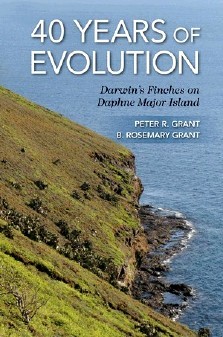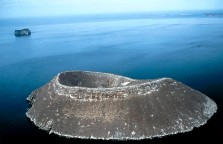|
40
years of evolution : Darwin's finches on Daphne Major island /
Peter R. Grant and B. Rosemary Grant. - Princeton (NJ) :
Princeton
university press, 2014. - XXXII-400 p. : ill.,
maps ;
25 cm.
ISBN
978-0-691-16046-7
|
|
Au
centre de l'archipel des Galápagos, à quelques
kilomètres au nord de l'île de Santa Cruz, Daphne
Major
est le sommet émergé d'un ancien volcan.
L'îlot
mesure moins d'un kilomètre dans sa longueur et culmine
à
120 mètres au-dessus du niveau de la mer ; il n'a
jamais
été habité, et n'héberge
que de rares
espèces animales et végétales, au
nombre
desquelles quelques dizaines de couples de ces pinsons (Geospiza
fortis, G. fuliginosa, G. magnirostris, G. scandens), dont, au XIXe
siècle, Darwin a relevé la
présence dans
l'archipel : ceux qui l'ont conduit à
élaborer sa
théorie de l'évolution.
Un couple
de chercheurs
américains a consacré 40 ans à
l'observation de
ces modestes oiseaux, accumulant une somme considérable de
données précieuses qui prolongent,
précisent et
font vivre l'intuition de leur grand
prédécesseur. Si
l'ouvrage est prioritairement destiné aux
spécialistes,
chacun peut y trouver matière à enrichir sa
connaissance
et sa réflexion : au cœur du Pacifique,
les pinsons
sont les acteurs d'une histoire de portée universelle, qui
reste
ouverte : Darwin
finches have much more to teach us (p. 318).
|
PUBLISHER'S
DESCRIPTION :
Renowned evolutionary biologists Peter and Rosemary Grant have produced
landmark studies of the Galápagos finches first made famous
by
Charles Darwin. In How
and Why Species Multiply,
they offered a complete evolutionary history of Darwin's finches since
their origin almost three million years ago. Now, in their richly
illustrated new book, 40
Years of Evolution,
the authors turn their attention to events taking place on a
contemporary scale. By continuously tracking finch populations over a
period of four decades, they uncover the causes and consequences of
significant events leading to evolutionary changes in species.
The
authors used a vast and unparalleled range of ecological, behavioral,
and genetic data — including song recordings, DNA
analyses,
and feeding and breeding behavior — to measure
changes in
finch populations on the small island of Daphne Major in the
Galápagos archipelago. They find that natural selection
happens
repeatedly, that finches hybridize and exchange genes rarely, and that
they compete for scarce food in times of drought, with the remarkable
result that the finch populations today differ significantly in average
beak size and shape from those of forty years ago. The authors' most
spectacular discovery is the initiation and establishment of a new
lineage that now behaves as a new species, differing from others in
size, song, and other characteristics. The authors emphasize the
immeasurable value of continuous long-term studies of natural
populations and of critical opportunities for detecting and
understanding rare but significant events.
By
following the fates of finches for several generations, 40 Years of Evolution
offers unparalleled insights into ecological and evolutionary changes
in natural environments.
| ❙ |
Peter
R. Grant and B. Rosemary Grant are both emeritus professors in the
Department of Ecology and Evolutionary Biology at Princeton University.
They are the coauthors of How
and Why Species Multiply and coeditors of In Search of the Causes of
Evolution. |
|
| CONTENTS |
Darwin's
finches on the Galápagos islands are a model system for the
study of speciation and adaptive radiation, that is, the rapid
evolution of morphologically and ecologically diverse species from an
ancestor. Core ingredients of a theory to explain how and why the
radiation occurred are natural selection, allopatric divergence,
reproductive isolation, and interspecific competition. Our task is to
determine how these ingredients occur, and how they are connected. In
this book we describe what we learned about evolution by studying four
species of ground finches on the single island of Daphne Major over a
period of 40 years.
☐ Chapter One, p. 16
|
|
Preface
PART
1
Early
problems, early solutions
1— Speciation,
adaptative radiation, and evolution
2—
Daphne finches : a question of size
3— Heritable
variation
4—
Natural selection and evolution
5—
Breeding ecology and fitness
PART
2
Developing
a long-term perspective
6— A
potential competitor arrives on Daphne
7—
Competition and character displacement
8—
Hybridization
9—
Variation and introgression
PART
3
Hybridization
and speciation
10—
Long-term trends in hybridization
11—
Long-term trends in natural selection
12—
Speciation
13—
Speciation by introgressive hybridization
PART
4
Syntheses
14—
The future of finches on Daphne
15—
Themes and issues
16—
Generalization
17—
Epilogue
Coda
Appendixes
Abbreviations,
Glossary, References, Subject index
|
|
| COMPLÉMENT
BIBLIOGRAPHIQUE |
- Charles
Darwin, « On the origin of species by means of
natural
selection, or The preservation of favoured races in the struggle for
life », London : John Murray, 1859
- Charles Darwin,
« Journal
de bord [Diary] du voyage du Beagle (1831-1836) »,
Paris : Honoré Champion (Classiques :
essais), 2012
- Charles Darwin,
« L'archipel des
Galápagos » Ch. XVII du Journal
of researches into the natural history and geology of the countries
visited during the voyage of H.M.S. Beagle round the world (2nd
ed., 1845), trad. par Michel Imbert, in Herman Melville, Les
îles enchantées, Marseille
: Le Mot et le reste, 2015
|
- Peter
R. Grant, « Ecology and evolution of Darwin's
finches », Princeton (NJ) : Princeton
university press,
1986, 1999
- Peter
R. Grant and B. Rosemary Grant, « Evolutionary
dynamics of a
natural population : the large cactus finch of the
Galápagos », Chicago :
University of Chicago
press, 1989
- Peter
R. Grant and B. Rosemary Grant, « How and why
species
multiply : the radiation of Darwin's
finches », Princeton (NJ) :
Princeton university press, 2008
|
- Jonathan Weiner, « The
beak of the finch : a story of evolution in our
time », New York : Knopf, 1994
|
| d'autres regards sur les
îles Galápagos |
- Christophe
Grenier, « Conservation
contre nature : les îles Galápagos »,
Paris : IRD Éditions (Latitudes 23), 2000
- Diane
de Margerie, « Isola,
retour des îles Galapagos »,
Paris : Pauvert, 2003
- Herman
Melville, « Les
îles enchantées »,
Paris : Éd. Mille et une nuits (Mille et une nuits,
148), 1997
- Herman
Melville, « Les
îles enchantées »
suivies de L'archipel
des Galápagos de Charles Darwin,
Marseille : Le Mot et le reste, 2015
- Georges
Simenon, « Ceux
de la soif », Paris : Gallimard
(Folio policier, 100), 1999
- Kurt
Vonnegut, « Galápagos »,
Paris : Grasset (Les Cahiers rouges, 198), 1994
|
|
|
| mise-à-jour : 2
juin 2016 |

|
 |
| Daphne Major, with Daphne Minor (Chica) in the
background (p. XXVIII) |
|
|
|
|